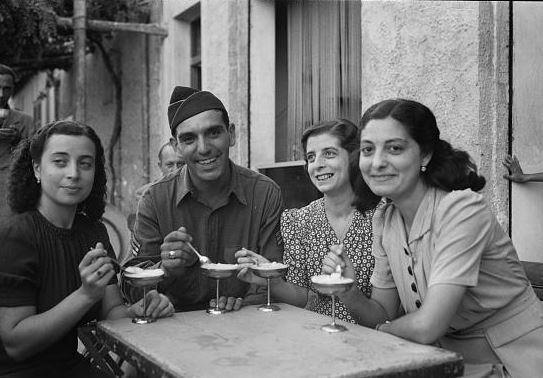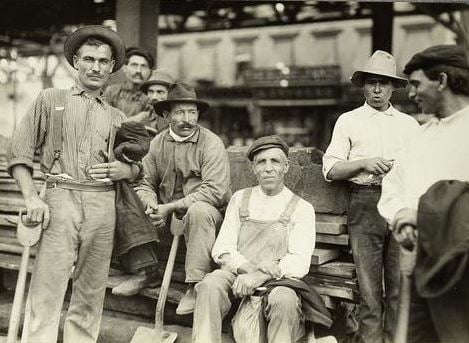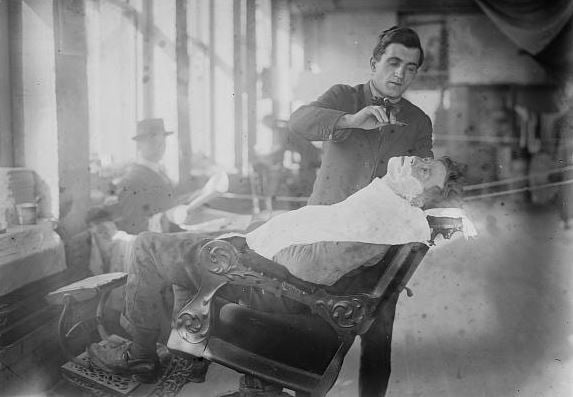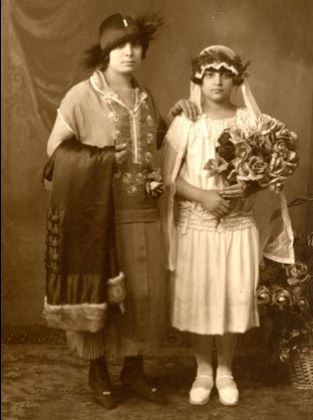Blog Archive
Hearts and Minds: Italian Americans and their Italian Ties

It pays to stay in touch. This photo from 1943 shows a U.S. soldier from Wisconsin who found his cousins in Palermo. Photo courtesy of the Library of Congress.
New York City Mayor Bill de Blasio is making a few special stops during his trip to Italy this summer. Some of these stops, such as meeting with Ignazio Marino, the mayor of Rome, he probably did not make when he first visited his maternal grandfather’s home town, Sant’agata de’ Goti, as a teenager in the 1970s. Bill de Blasio’s maternal grandfather, Giovanni de Blasio, immigrated to New York from a small town near Naples . While Giovanni was relatively comfortable financially, he left southern Italy with the same hope as many Southern Italians at that time: to make it in America.

The beauty of Italy remained not only in the minds of the émigrés but developed in the popular imagination of the rest of the United States. This travel poster for Palermo was created in 1920 around the time of the mass migration from that region. Photo courtesy of the Library of Congress.
One of the families who lived at 97 Orchard Street was the Baldizzi family. The Baldizzis were from Sicily and were part of a similar wave of immigration to that of the Giovanni de Blasio. The Italian experience of immigration to the United States was different for northern and for southern Italians. Northern Italians immigrated earlier to the U.S than their southern countrymen. By 1870 there were about 25,000 Italian immigrants, mostly northern Italians who were escaping political turmoil and the Risorgimento, the wars surrounding Italian independence and reunification. The wave of immigration from southern Italy and Sicily was affected by a variety of what historians call push factors: high taxes, scarcity of fertile farmland, and several natural disasters including tidal waves and eruptions from both Mt. Etna and Mt. Vesuvius. Giovanni de Blasio left Sant’Agata in 1905. In that same year, 7,849 citizens left that area.
Aldopho Baldizzi was from Palermo, a Scilian town that also saw huge numbers of emigrants in the early years of the Twentieth Century. Aldolpho was a skilled carpenter. Despite his prowess, in Sicily he made only about $1.80 a week for his work and had heard rumors that carpenters in New York he could make closer to $18 a week. Aldopho had higher hopes for his young family. He was married to Rosaria Mutolo ,the daughter of the woman who sold him eggs. He left Sicily in 1923 without Rosaria. Traveling as a single young man was somewhat common among southern Italian immigrants because,unlike some of the Eastern European Jewish families who left their homes to escape persecution, some Italian immigrants held the possibility of return in case they found they could not make ends meet in the United States. Eventually, Aldolpho Baldizzi gained a foot-hold in New York and saved enough money for Rosaria to come join him. Many Italian immigrants did however return home. Between 1900 and 1910 40% of Italian immigrants returned to Italy – these immigrants were called the ritornati.

This photo depicts a group of Italian day laborers in 1910 under the Sixth Avenue elevated. Photo courtesy of the New York Public Library.
Italian immigrants also continued to send money, when they had it, home to families and villages in Italy. In 1896 a U.S. government commission estimated that Italians sent somewhere between $4 and $30 million annually back to Italy. Giovanni de Blasio sent chocolate and clothing back to Sant’Agata to be distributed by his brother, who was a priest. Giovanni also bought the first television in the town when he returned for a visit in 1953 and invited his neighbors to watch with him.
Josephine Baldizzi , the daughter of Adolpho and Rosaria, lived in 97 Orchard until she was 9 years old. She shared some of her memories with Museum. One of her memories is hearing her mother listening to Italian radio and opera constantly in the apartment: “The radio, always playing: Italian music, Italian soap operas, and my mother crying all the time (chuckles). She used to miss her family. She left her whole family in Italy, came here as a young girl and she never saw them again for many, many years later.” While Bill de Blasio might not listen to Italian soap operas (he’s got other things to do!), he has managed to maintain his ties to his grandfather’s country: he practices his Italian with his barber here in NYC to main his proper southern Italian accent!

Don't underestimate the bonds between a man and his barber. This man gets a shave some time between 1910 and 1915. Photo courtesy of the Library of Congress.
-Posted by Julia Berick
